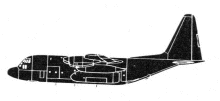Incident Overview

Description
A DHC-8 passenger plane, registered TF-JMB, sustained substantial damage in a landing accident at Godthb/Nuuk Airport (GOH), Greenland. All 31 passengers and three crew members survived. The airplane operated on a flight from Reykjav¡k Domestic Airport (RKV), Iceland to Godthb/Nuuk Airport (GOH), Greenland with an enroute stop at Kulusuk. At 12:58, the flight crew of TF-JMB made radio contact with Nuuk AFIS and were informed that the runway in use was 23. The weather was reported to be: wind direction from 170ø at a speed of 24 kts with a maximum of 43 kts, the visibility was 4,000 meters in light snow, moderate blowing snow, a few clouds at 1,800 feet, broken clouds at 3,500 feet, the temperature was zero, the dew point was minus four Celsius and the QNH was 1014 hPa. The flight crew made visual contact with the runway and decided to deviate to the right (west) of the offset Localizer (LLZ) to runway 23. The flight continued towards the runway from a position right of the runway centerline. The flight crew was aiming to land the aircraft at a point between the runway threshold and the touchdown zone. As the aircraft approached runway 23 it was still in the final right turn over the landing threshold. The aircraft touched down on runway 23 between the runway threshold and the touchdown zone and to the left of the runway centerline. The Flight Data Recorder (FDR) data indicated that the aircraft was banking more than 11ø to the right as the aircraft touched down. At the same time the vertical acceleration was approximately 3.9 G and the rate of descent was greater than 13 feet per second. The right main landing gear (MLG) shock strut fuse pin sheared and the right MLG collapsed, the aircraft skidded down the runway and departed the runway to the right. The nose landing gear was separated from the aircraft as the aircraft was entering the unpaved surface. The aircraft came to rest in the rocky area to the right of runway 23. Adverse wind and turbulence conditions at BGGH led to flight crew task saturation on final approach and a breakdown of optimum cockpit resource management (CRM) resulting in a divergence from the operators stabilized approach policy. The divergence from the operators stabilized approach policy caused an unstabilized approach and a hard landing leading to an excess load of the right MLG at touchdown. According to its design, the right MLG fuse pin sheared as a result of stress
Source of Information
http://www.visir.is/islensk-vel-brotlenti-a-flugvellinum-i-nuuk—allir-farthegar-omeiddir/article/2011110309425, http://www.skybrary.aero/index.php/DH8A,_Nuuk_Greenland,_2011_(RE_HF)http://www.visir.is/islensk-vel-brotlenti-a-flugvellinum-i-nuuk—allir-farthegar-omeiddir/article/2011110309425, http://www.skybrary.aero/index.php/DH8A,_Nuuk_Greenland,_2011_(RE_HF)Primary Cause
Stress fracture of the fuse pin in the right main landing gear strut, leading to a catastrophic failure during final approach and landing.Stress fracture of the fuse pin in the right main landing gear strut, leading to a catastrophic failure during final approach and landing.Share on:





